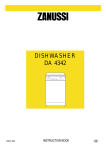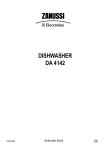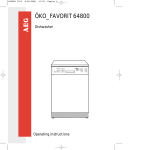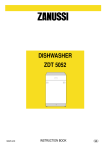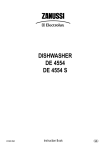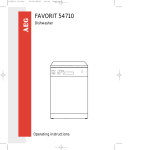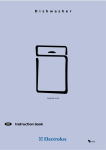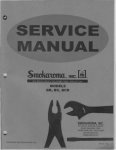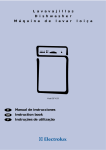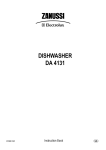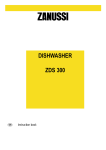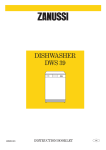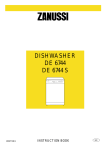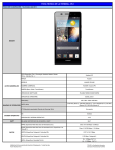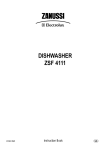Download Zanussi DE 4744 Instruction Booklet
Transcript
DISHWASHER DE 4744 152977 36/2 INSTRUCTION BOOK UK Contents For the user For the installer Important safety information 3 Description of the appliance 4 The control panel 5 Before use Setting the water softener Rinse aid 6 6 9 Using your appliance Loading your appliance Adjusting the height of the upper basket Use of detergent 10 10 12 13 Hints and tips 14 Washing programmes 15 Operating sequence 16 Maintenance and cleaning Internal cleaning Cleaning the filters External cleaning Prolonged periods of non-operation Frost precautions Moving the machine 18 18 18 19 19 19 19 Something not working Protection against flooding 20 21 Hints for test centres Technical specifications 22 22 Installation instructions Water supply connections Water outlet hose connection Electrical connection 23 23 24 25 Fitting under a counter Levelling 26 26 Guide to use the instruction book The following symbols will be found in the text to guide you throughout the instructions: Safety instructions 1. 2. 3. Step by step Hints and tips Environmental information 2 Important safety information It is most important that this instruction book should be retained with the appliance for future reference. Should the appliance be sold or transferred to another owner, or should you move house and leave the appliance, always ensure that the book is left with the appliance in order that the new owner can get to know the functioning of the appliance and the relevant safety information. This information has been provided in the interest of your safety. You MUST read it carefully before installing or using the appliance. Installation ● This appliance is heavy. Care should be taken when moving it. ● When finishing loading or unloading close the door, as an open door can be a hazard. ● Do not sit or stand on the open door. ● It is dangerous to alter the specifications or attempt to modify this product in any way. ● Isolate the appliance from the power supply and turn off the water supply after use. ● Care must be taken to ensure that the appliance does not stand on the electrical supply cable. ● Care should be taken when cleaning the bottom door seal and hinge area as any exposed metal edges may cut if care is not taken. ● Any electrical work required to install this appliance should be carried out by a qualified electrician or competent person. ● This product should be serviced by an authorised Service engineer, and only genuine spare parts should be used. ● Under no circumstances should you attempt to repair the machine yourself. Repairs carried out by inexperienced persons may cause injury or serious malfunctioning. Contact your local Service Force Centre. Always insist on genuine spare parts. ● Any plumbing work required to install this appliance should be carried out by a qualified plumber or competent person. Child Safety ● This appliance is designed to be operated by adults. Children should not be allowed to tamper with the controls or play with the product. ● Keep all packaging well away from children. ● Keep all detergents in a safe place out of children's reach. Conservation In the interest of the environment: During Use ● Items that are contaminated by petrol, paint, steel or iron debris, corrosive, acidic or alkaline chemicals must not be washed in this dishwasher. ● Under no circumstances should you open the door whilst the appliance is in operation. Always turn off the appliance before opening the door. ● Only use detergent specifically designed for use in dishwashers. ● Long bladed knives stored in an upright position are a potential hazard. ● Long and/or sharp items of cutlery such as carving knives must be positioned horizontally in the upper basket. 3 ● Materials marked with the symbol recyclable. are ● Check with your local Council or Environmental Health Office to see if there are facilities in your area for re-cycling this appliance. ● When the appliance is to be scrapped, cut off the power supply cable and make the door closing device unusable to prevent young children from being trapped inside. ● Help to keep your country tidy - use authorised disposal sites for your old appliance. Description of the appliance IN132 1. Levelling spacers 10. Upper basket 2. Upper basket stop 11. "SID" detergent dispenser (Super Intensity Dispenser) 3. Upper spray arm 12. Worktop 4. Salt container 5. Detergent dispenser 6. Control panel 7. Rinse aid dispenser 8. Filters 9. Lower spray arm 4 The control panel 1. ON-OFF indicator light 7. Indicator lights Phase indicator lights 2. ON-OFF push button WASHING phase illuminates when the washing phase is running 3. Door handle DRYING phase illuminates when the drying phase is running 4. Programme selection push buttons END OF PROGRAMME illuminates when the washing programme has ended Salt and rinse aid indicator lights 5. HALF LOAD push button SALT refilling indicator light illuminates when the salt has run out and the salt container requires refilling. This option is useful and economical when only a few dishes need washing. By pressing this push button, the corresponding indicator light comes on and the prewash phase is automatically excluded. If the indicator light is off, the washing programme will be carried out completely. Remember to load all the dishes into both baskets. With programme QUICK A 30 this option is automatically deactivated. RINSE AID refilling indicator light illuminates when the rinse aid has run out and the rinse aid container requires refilling. 6. DELAY START push button This option allows the start of the programme to be delayed by 3, 6 or 9 hours. 5 Before use Before using your dishwasher for the first time: 1. Ensure that the electrical and water connections comply with the installation instructions 2. Remove all packaging from inside the appliance 3. Set the water softener 4. Pour 1 litre of water inside the salt container and then fill with salt 5. Fill the rinse aid dispenser. Setting the water softener The dishwasher is equipped with a water softener designed to remove minerals and salts from the water supply, which would have a detrimental or adverse effect on the operation of the appliance. The higher the content of these salts, the harder your water is. Water hardness Water hardness is measured in equivalent scales, Clarke degrees, French degrees and PPM (parts per Million). The softener should be adjusted according to the hardness of the water in your area. Your local Water Authority can advise you on the hardness of the water in your area. Level Clarke degrees French degrees (°TH) PPM (Parts per Million) Use of salt 1 2 3 4 5 <6 6 - 21 22 - 35 36 - 49 50 - 63 <8 8 - 30 31 - 50 51 - 70 71 - 90 < 80 81 - 300 301 - 500 501 - 700 701 - 900 NO YES YES YES YES The dishwasher is factory set at level 3. If this level is not suitable for your area the softener should be adjusted. To select a different level be sure that the dishwasher is off and then proceed as follows: 1. Press INTENSIVE SID 80 and NORMAL programme push buttons simultaneously. 2. Always keeping pressed the programme push buttons INTENSIVE SID 80 and NORMAL switch on the dishwasher by pressing the ON-OFF push button. The ON-OFF indicator light comes on. At the same time, also the indicator light of the INTENSIVE SID 80 comes on and remains fixed for about 5 seconds, after this it starts flashing indicating the current level of the water softener. SO362 6 The current level is indicated by the number of flashes made by the INTENSIVE SID 80 indicator light, that alternates 5 seconds off with a number of flashes, this continues for about 60 seconds. Example: 1 flash = 2 flashes = 3 flashes = 4 flashes = 5 flashes = level 1 level 2 level 3 level 4 level 5 3. To change the level, press the INTENSIVE SID 80 programme push button. Each time the push button is pressed the level changes. Example: If the current level is 3, pressing only one time the INTENSIVE SID 80 programme push button, level 4 is selected. If the current level is 5, pressing only one time the INTENSIVE SID 80 programme push button, level 1 is selected. The INTENSIVE SID 80 indicator light remains off for about 5 seconds after which starts flashing indicating the new level selected. 4. To memorise the new level, switch off the dishwasher by pressing the ON-OFF push button. If your water is level 1 it is already soft and therefore there is no need to use salt. With the setting of the water softener at level 1 the salt indicator light on the control panel will always remain off. Use salt from level 2 upwards. From level 2 upwards, if salt refilling is necessary, the salt indicator light will illuminate only in setting mode and at the end of the washing programme. During the run of the programme it will remain off. 7 Filling with salt Only use salt specifically designed for use in dishwashers. All other types of salt not specifically designed for use in a dishwasher, especially table salt, will damage the water softener. Only fill with salt just before starting one of the complete washing programmes. This will prevent any grains of salt or salty water, which may have been spilled, remaining on the bottom of the machine for any period of time, which may cause corrosion. To fill: 1. To fill with salt, unscrew the cap of the salt container. 2. Pour 1 litre of water inside the container (this is necessary only before filling with salt for the first time). LE SA LT SA LZ SA L SE 3. Using the funnel provided, pour in the salt until the container is full. Do not worry if water over flows from the unit when filling with salt, this is quite normal. 4. Replace the cap making sure that there is no trace of salt on the screw thread or on the gasket. 5. Screw on the cap tightly. SR06 The salt container will require topping up periodically. You are reminded of this by the salt indicator light on the control panel which comes on when the salt has finished. The salt indicator light on the control panel can remain illuminated for 2-6 hours after the salt has been replenished, assuming the dishwasher remains switched on. If you are using salts that take longer to dissolve then this can take longer. The function of the machine is not affected. 8 Rinse aid Rinse aid is automatically added during the last rinse, ensuring thorough rinsing, and spot and streak free drying. The dispenser, which is positioned inside the door, holds about 110 ml of rinse aid, which is sufficient for 16 - 40 dishwashing programmes, depending upon the dosage setting. Filling with rinse aid 1. Open the container by turning the lid (A) anticlockwise. A BR01 2. Add the rinse aid until the container is completely full. The indicator (B) will be completely dark. 3. Top up the rinse aid when the rinse aid indicator light on the control panel illuminates. B m a x 6 5 4 3 2 1 If rinse aid refilling is necessary, the rinse aid indicator light will illuminate only in setting mode and at the end of the washing programme. During the run of the programme it will remain off. BR03 Ensure that the lid is closed after every refill. Do not put liquid detergent in the rinse aid compartment. Clean up any rinse aid spilt during filling with an absorbent cloth to avoid excess foaming during the next wash. Adjusting the dose According to the finish and drying results obtained, adjust the dose of rinse aid by means of the 6 position selector (C) (position 1 minimum dosage, position 6 maximum dosage). Increase the dose if there are drops of water or lime spots on the dishes after washing. Reduce it if there are sticky whitish streaks on the dishes. BR02 9 x 6 5 4 3 2 1 m a C Using your appliance Loading your appliance Before placing dishes in the machine, remove any scraps of food, to avoid clogging the filters and consequently reducing the performance. Do not load very small items which can fall through the baskets. Open the door and slide out the baskets to load the dishes. UI61 The lower basket The lower basket is designed to take saucepans, lids, plates, salad bowls, cutlery etc. Serving dishes and large lids should be arranged around the edge of the basket, ensuring that the upper spray arm can turn freely. UI24 The two rear rows of prongs on the lower basket can be easily lowered to allow you to load pots, pans and bowls. To lower the prongs: - Slightly pull them upward and let them drop down (see picture). - To bring them back to the standing position, just pull them up again. UI84 10 UI83 The cutlery basket Long bladed knives stored in an upright position are a potential hazard. These items should only be placed in the removable knife basket. Take care when loading or unloading sharp items such as knives. Removable knife basket Long and/or sharp items of cutlery such as carving knives must be placed horizontally in the removable knife basket, which is positioned at the left side of the upper basket. UI55 Cutlery should be placed in the removable cutlery basket with the handles facing downwards. If the handles protrude from the bottom of the basket, obstructing the lower spray arm, load the cutlery with the handles facing upwards. Mix spoons with other cutlery to prevent them from sticking together. Silver cutlery tends to go black if mixed with steel cutlery. Place it in the cutlery basket separate from the others. For best results we recommend to use the cutlery grid provided (if the size and the dimensions of the cutlery allow it). UI10 UI76 11 The upper basket The upper basket is designed for plates (dessert plates, saucers, dinner plates of up to 25 cm in diameter), salad bowls, cups and glasses. Arrange items on and underneath the cup racks so that water can reach all surfaces. The cup rack on the left folds upwards to increase your loading flexibility. Glasses with long stems can be placed upside down in the cup racks. US69 Light items (plastic bowls etc.) should be loaded in the upper basket and arranged so they do not move. Before closing the door, ensure that the spray arms can rotate freely. Adjusting the height of the upper basket If washing very large plates (over 27 cm and up to 32 cm in diameter) you can load them in the lower basket after moving the upper basket to the higher position. A To move to the higher position proceed as follows: 1. Move the front runner stop (A) of the upper basket outwards and slide the basket out. 2. Refit the basket in the higher position and replace the stops (A) in their original position. RC01 When the top basket is in the higher position it will only take plates up to 20 cm in diameter and you will not be able to use the raised cup racks. After loading your machine always close the door, as an open door can be a hazard. 12 Use of detergent Only use detergents specifically designed for use in dishwashers. We recommend the use of Finish detergents which are available in the following options: Finish Double Action Tablets. Each tablet has the exact amount of detergent required, simply place in the dispenser. Finish Powder recommended for every day use. Finish Liquid Gel ideal for every day use. As the gel is extra gentle it is recommended for fine bone china. Min = 15 g Max = 30 g D If using powder detergents proceed as follows: 1. Open the dispenser lid by pulling the catch (D). 2. Add the detergent according to the instructions given in the Washing programmes chart. As all detergents are not the same, you should also consult the instructions on the packet. M M IN AX 3. Always close the lid. DE17 4. If the programme has a prewash add a little amount of detergent in the SID detergent dispenser, located in the centre of the upper basket. Follow the recommended quantity of detergent given in the Washing programmes chart. If using detergent in tablets proceed as follows: 1. For all programmes; place 1 tablet inside the detergent dispenser. DE14 2. Always close the lid. 3. For all programmes with prewash; place a portion of a further tablet on the lid of the detergent dispenser. Insufficient quantities of detergent will produce poor washing results, whereas an excessive amount of detergent will not improve washing results and is also wasteful. Using no more than the correct amount also contributes to reducing pollution. Compact detergents with enzymes In these compact powders the environmentally unfriendly components have been replaced by natural enzymes and other more biodegradable substances. The enzymes deploy their full dirt dissolving power at a temperature as low as 50°C. By choosing the ECONOMY programmes you can therefore achieve the same cleaning results that would otherwise be achievable only with 65°C programmes and conventional detergents. 13 Hints and tips To save energy Items not suitable for dishwashers Place dishes in the machine immediately after every meal and wait until the dishwasher is full before washing. Do not prewash dishes under running water. Select the QUICK A 30 programme when dishes are not very soiled, following the instructions given in the "Washing programmes" chart. Select the HALF LOAD option if only a few dishes need washing. Remember to load the dishes in both baskets. The following items should not be washed in the dishwasher (unless they are sold as dishwasher proof): - Cutlery with wooden or horn handles or glued parts - bronze cutlery - saucepans with wooden handles - aluminium ware - crystal ware - leaded glass - plastic items - antique or fine decorated china For best washing results Certain types of decoration can discolour when washed in a dishwasher. Crystal-ware and plastic objects, if not guaranteed dishwasher proof should be washed by hand. Certain types of glass can also become opaque after being washed several times in a dishwasher. A chemical reaction can occur between silver cutlery and stainless steel cutlery. As a precaution, do not wash together. Iron and cast iron objects can rust and stain other items. Aluminium tends to go black, copper, pewter and brass tend to stain. Before loading, remove all scraps of food and soak very heavily soiled pots and pans. Arrange saucepans, cups and glasses etc. upsidedown. Tilt items with convex or concave surfaces so that the water drains off easily. Avoid contact between the dishes as far as possible. If in doubt check with manufacturer of the item. When buying new dishes, ensure that they are dishwasher proof. For best results we recommend the use of Finish detergents, rinse aid and salt. EASY POURING PACK N EW TION DOUBLE AC FOR A BRILLIANT SHINE L I Q U I D G E L P O W D E R RINSE C O N C E N T R AT E D D I S H WA S H E R D E T E R G E N T DE15 14 Washing programmes Type of load Degree of soil Required push buttons Recommended quantity of detergent wash * 70° INTENSIVE SID 80 65° NORMAL ** 60° QUICK A 30 *** 50° ECONOMY Heavy soil. Crockery, cutlery, pots and pans ON-OFF + INTENSIVE SID 80 15 g Cycle description prewash 10 g Hot prewash Main wash up to 70°C 1 cold rinse 1 hot rinse Active dry Normal soil. Crockery and cutlery ON-OFF + NORMAL 20 g 5g Cold prewash Main wash up to 65°C 1 cold rinse 1 hot rinse Active dry Fresh soil. Crockery and cutlery ON-OFF + QUICK A 30 25 g / Main wash up to 60°C 1 hot rinse Normal soil. Crockery and cutlery ON-OFF + ECONOMY 5g Cold prewash Main wash up to 50°C 2 cold rinses 1 hot rinse Active dry 20 g * Ideal for washing a complete load of 9 place settings with normal soil. Characterised by a duration of about 80 minutes and a washing temperature of 70°C. The time value is approximated and depends on the pressure and the temperature of the water and also by the variations of the power supply. This is the daily programme for excellence. ** Ideal for washing crockery and cutlery of breakfast and dinner (fresh soil). Characterised by a duration of about 30 minutes and a washing temperature of 60°C. The time value is approximated and depends on the pressure and the temperature of the water and also by the variations of the power supply. This is the perfect daily programme, made to meet the needs of a family of 4 persons who only wish to load breakfast and dinner crockery and cutlery. *** Testing programme for EN 50242 (see "Hints for Test Centres). 15 Operating sequence 1. Check the filters 8a. Setting and starting the programme without DELAY START Ensure they are clean and properly positioned (see "Maintenance and cleaning"). Press the push button corresponding to the wanted programme: the indicator light corresponding to the programme illuminates and the phase indicator lights foreseen for that programme start flashing. 2. Press the ON-OFF push button The ON-OFF indicator light will come on. Select, if required, the HALF LOAD option. The start of the programme will occur after about 6 seconds from the last pressure of a push button (programme or HALF LOAD push button), in this time it is possible to change programme simply pressing the push button of another programme. 3. Check that there is rinse aid and salt The corresponding indicator lights will illuminate if refilling is necessary. Once the programme has started the phase indicator lights will turn off except for the phase under way. 4. Load the dishes Remove any scraps of food. Pull the lower basket out and arrange the saucepans, plates and cutlery in it. Pull the upper basket out and arrange the plates, saucers, glasses and cups etc. in it. Slide the baskets back into the machine. It is possible to interrupt the programme by: ● opening the door ● pressing the ON-OFF push button (in this case all the indicator lights turn off) Close the door again o press the ON-OFF, the programme will start from the point in which it was interrupted. 5. Ensure that the spray arms can rotate freely. 8b. Setting and starting the programme with DELAY START 6. Measure out detergent Add the required amount of detergent into the dispenser according to the recommended quantity given in the Washing programmes chart. The setting of the delay start occurs before selecting the programme. Press the DELAY START push button and selected the desired time (3, 6 or 9 hours) until the indicator light corresponding to the chosen hours flashes. Important! If the half load option is selected remember to reduce the quantity of detergent. Press the push button corresponding to the wanted programme: the indicator light corresponding to the programme illuminates and the phase indicator lights foreseen for that programme start flashing. Close the detergent dispenser lid. 7. Close the dishwasher door The start of the countdown will occur after about 6 seconds from the last pressure of a push button (programme or HALF LOAD push button). The countdown will decrease with step of 3 hours and you are informed of this by the indicator lights of the hours. 16 During the countdown the only indicator lights illuminate are the programme light and the light of the number of hours to the start of the programme. Empty the lower basket first and then the upper one; this will avoid water dripping from the upper basket onto the dishes in the lower one. Once the delayed time has elapsed the programme will start automatically. Important! In general it is not advisable to open the door while the machine is working; if the door is opened however, a safety device ensures that the machine stops. Care must be taken if the door is opened during the hot phase or immediately after a programme has finished, as steam may escape. It is possible to stop a countdown in progress or before it starts, simply pressing the DELAY START push button until the indicator lights of the hours are off: 9. To cancel a programme in progress A programme in progress can be cancelled at any time. When the washing programme has finished, it is recommended that the dishwasher is unplugged and the water tap turned off. Press for about 3 seconds the push button of the running programme until all indicator lights are off. Only the ON-OFF indicator light will remain on once the programme has been cancelled. It is now possible to select a new washing programme. 10. At the end of the washing programme The dishwasher will automatically stop and the phase indicator light end of programme will come on. The indicator light of the programme just ended will remain on. The dishwasher has finished the programme only when the phase indicator light end of programme is illuminated. If you do not wait for the end of the programme it will not be possible to start a new programme if first you do not cancel the previous. (For instructions on how to cancel a programme see point 9) Switch off the dishwasher by pressing the ONOFF push button. Wait 15/20 minutes before opening the dishwasher’s door; in this way you will avoid burning yourself when removing the dishes and avoid also the damage of the nearby furniture caused by the escape of steam. 17 Maintenance and cleaning Internal cleaning Ensure that the seals around the door, the detergent and rinse aid dispensers are cleaned regularly with a damp cloth. We recommend the use of Finish Dishwasher Cleaner every 3 months or run a 65°C wash without dishes using detergent. Regular use of Finish Dishwasher Cleaner cleans inaccessible parts, eliminates unpleasant food odours and helps prevent the build-up of limescale. Cleaning the filters The filters in the base of the washing compartment are to a large extent self-cleaning. Nevertheless the filters should be checked and cleaned from time to time. Dirty filters will degrade the washing result. 1. Open the door, remove the lower basket. 2. The dishwasher filter system comprises a coarse/fine filter, microfilter and a flat filter. Unlock the filter system using a handle on the microfilter, and remove. 3. Turn the handle about 1/4 a turn anticlockwise and remove. MA15 4. Take hold of the coarse/fine filter (1/2) by the handle with the hole and remove from the microfilter (3). 5. Clean all filters thoroughly under running water. 6. Remove the flat filter (4) from the base of the washing compartment and clean both faces thoroughly. 7. Put the flat filter back in the base of the washing compartment. 8. Place the coarse/fine filter in the microfilter and press together. MA17 9. Put the filter combination in place and lock by turning the handle clockwise to the stop. During this process ensure that the flat filter does not protrude above the base of the washing compartment. The dishwasher must not be used without filters. Incorrect repositioning and fitting of the filters will produce poor washing results. Cleaning the filters is vital to ensure correct operation of the machine. MA16 18 4 Check that the SID is not clogged with detergent residue. If necessary rinse it under running water after having removed it from the basket by twisting it anticlockwise and pulling it upwards. Fasten it back onto the support by turning it clockwise. Never use your dishwasher without the SID dispenser. Since SID also ensures correct distribution of the water to the upper spray arm, running the dishwasher without it will impair the washing results. MA12 External cleaning Clean the external surfaces of the machine and control panel with a damp soft cloth. If necessary use only neutral detergents. Never use abrasive products, scouring pads or solvent (acetone, trichloroethylene etc....). Prolonged periods of nonoperation If you are not using the machine for any period of time you are advised to: 1. Unplug the appliance and then turn off the water. 2. Fill the rinse aid dispenser. 3. Leave the door ajar to prevent the formation of any unpleasant smells. 4. Leave the inside of the machine clean. Frost precautions Avoid placing the machine in a location where the temperature is below 0°C. If this is unavoidable, empty the machine, close the appliance door, disconnect the water inlet pipe and empty it. Moving the machine If you have to move the machine (moving house etc....): 1. Unplug it. 2. Turn the water tap off. 3. Remove the water inlet and discharge hoses. 4. Pull the machine out together with the hoses. Avoid over tilting the machine during transportation. 19 Something not working Certain problems are due to lack of simple maintenance or oversights, which can be solved easily without calling out an engineer. The dishwasher is fitted with a number of alarm systems which can help you to quickly determine the cause of any problems. The dishwasher will not start or stops during operation. All push buttons are inoperative except for the ON-OFF push button. The indicator light of the programme under and one or more of the phase indicator lights (WASHING, DRYING, END OF PROGRAMME) are flashing. Press the ON-OFF push button to switch off the dishwasher and carry out the following suggested corrective actions listed below. Once the checks have been carried out switch on the dishwasher and start a washing programme, if the fault code reappears in the digital display, contact your local Service Force Centre. Important: If you call out an engineer to a fault listed below or to repair a fault caused by incorrect use or installation a charge will be made, even if the appliance is in guarantee. Symptom Fault code The machine will not start Solution ● ● ● The machine does not fill with water WASHING phase indicator light flashing ● ● ● ● The dishwasher will not drain DRYING phase indicator light flashes The door has not been properly closed. The plug is not properly inserted in the power socket. There is a power failure. Ensure the water tap is open. Ensure the mains water supply has not been cut off. The inlet hose may be squashed or bent. Reposition the hose. The inlet hose may be blocked. Switch off the water supply and clean the filter. ● The drain hose may be squashed or bent. Reposition the hose. The sink may be blocked. Clear any blockages. The drain hose extension is not correct. Follow the instructions for connecting to the waste. There is no vent in the end of the drain hose. ● ● ● Protection against flooding is active WASHING and DRYING phase indicator lights are flashing ● Close the water tap and contact the Service Force Centre. General One or more phase indicator lights are flashing ● Switch off the dishwasher. Switch it back on and start the programme. If the alarm reappears, call the local Service Force Centre. ● Dishes are rattling against each other, refer to “Loading your machine”. The spray arms are knocking against the dishes. Refer to "Loading your machine". The machine is noisy ● The door is difficult to close ● The dishwasher is not level, or not properly built-in. Visible lime deposits or white film on the dishes ● ● Check that there is salt and that the salt cap is tight. Check that the right level of the water softener is set. The dishes are not quite dry ● The rinse aid has run out or too little is being used. The dishes are not clean (poor wash) ● The baskets are too full. The dishes have not been arranged properly. The spray arms do not rotate The spray arms are clogged. The filters are clogged. The filters are not in the correct position. Not enough detergent has been used or it is unsuitable. The detergent is old or has gone hard. The salt container cap is not properly closed. The washing programme selected is too gentle. ● ● ● ● ● ● ● ● ● 20 If after all these checks, the problem persists, contact your local Service Force Centre, quoting the model and serial number. This information can be found on the rating plate located on the right hand side of the dishwasher door (see picture). Protection against flooding Prod.No. ........ Ser. No. ......... Mod. ........ RA01 The machine is fitted with a device in the bottom of the machine to protect against flooding. The device will operate if there are any water leaks in the machine, however it will only operate if the machine is on. In case of malfunction, the WASHING and DRYING phase indicator lights start flashing. To repair the dishwasher, turn off the water tap and call the Service Force Centre. 21 Hints for test centres Before starting any test it is necessary to fill completely with salt the salt container and with rinse aid the rinse aid dispenser. Test standard EN 50242 Reference programme: ECONOMY 50° Load: 9 standard place settings Rinse aid selector: position 4 Detergent dosage : 20 g in the dispenser 5 g on the dispenser lid Arrangement lower basket Arrangement upper basket Arrangement cutlery basket Technical specifications Dimensions Width Height with worktop Height without worktop Max depth Max depth with open door Electrical connection Motor rating during wash Power of heating element Overall power Voltage Water supply pressure Minimum Maximum Capacity 45 cm 85 cm 82 cm 63 cm 115.9 cm 220/240 V - 50 Hz 200 W 2100 W 2300 W 50 kPa (0.5 bar) 800 kPa (8 bar) 9 place settings 22 Installation instructions Any electrical work required to install this appliance should be carried out by a qualified electrician or competent person. Any plumbing work required to install this appliance should be carried out by a qualified plumber or competent person. Remove all packaging before positioning the machine. If possible, position the machine next to a water tap and a drain. Water supply connections This dishwasher must be plumbed into a cold water supply. The water pressure must be within the limits given in the technical specifications. Your local Water Authority will advise you on the average mains pressure in your area. The dishwasher features fill and drain hoses which can be turned either to the left or the right to suit the installation. Do not use, for the connection, old hoses which have been used in another appliance. The locknut must be correctly fitted to avoid water leaks. Avoid bends or kinks in the hose which could prevent or slow down the water supply. If the machine is connected to new pipes or pipes which have not been used for a long time, you should run the water for a few minutes before connecting the inlet hose. This will prevent deposits of sand or rust clogging the inlet hose filter. 23 Water outlet hose connection 2 Ø 1. To the sink outlet spigot, securing it if necessary with a clip. 18 Ø 21 min 4 cm 1 The end of the drain hose can be connected in the following ways: min 30 cm max 100 cm 2. Hooked over the edge of the sink using the special curved plastic guide provided. 3. To a stand pipe provided with vent-hole, minimum internal diameter 4 cm. CS13 Ø 18 Ø 21 The drain hose can face either to the right or left of the dishwasher Ensure the hose is not bent or squashed as this could prevent or slow down the discharge of water. The sink plug must not be in place when the machine is draining as this could cause the water to siphon back into the machine. + 2 m max CS14 If you use a drain hose extension it must be no longer than 2 metres and its internal diameter must be no smaller than the diameter of the hose provided. Likewise the internal diameter of the couplings used for connections to the waste outlet must be no smaller than the diameter of the hose provided. Attention! Our appliances are supplied with a security device to protect against the return of dirty water back into the machine. If the spigot of your sink has a "no return valve" incorporated this can prevent the correct draining of your dishwasher. We advise you therefore to remove it. 24 min 30 cm max 100 cm The waste connection must be at a height of between 30 cm (minimum) and 100 cm (maximum) from the bottom of the dishwasher. Electrical connection This appliance must be earthed. The manufacturer declines any responsibility should this safety measure not be observed. If the plug that is fitted to your appliance is not suitable for the socket, it must be cut off and the appropriate plug fitted. Important The wires on the mains lead are coloured in accordance with the following code: Green and Yellow -Earth Blue -Neutral Brown -Live If you fit your own plug, the colours of the wires in the mains lead of your appliance may not correspond with the markings identifying the terminals in your plug. Proceed as follows: 1. Connect the Green and Yellow (earth) wire to the terminal in the plug which is marked with the letter "E" or the earth symbol or coloured green and yellow. 2. Connect the Blue (neutral) wire to the terminal in the plug which is marked with the letter "N" or coloured black. 3. Connect the Brown (live) wire to the terminal in the plug which is marked with the letter "L" or coloured red. CE03 The plug moulded onto the lead incorporates a 13amp BSI362 fuse. Only ASTA or BSI fuses should be used. The plug must not be used if the fuse cover/carrier is lost. The cover/carrier is indicated by the coloured insert at the base of the product. A replacement cover/carrier must be obtained from your local Service Force Centre. This appliance complies with the following E.E.C. Directives: - 73/23 or 19.2.73 (Low Voltage Directive) and subsequent modifications; - 89/336 or 3.5.89 (Electromagnetic Compatibility Directive) and subsequent modifications. 25 Fitting under a counter (kitchen worktop or sink) By removing the machine’s worktop, you can install it under a close fitting sink unit or a pre-existing top, providing the dimensions of the recess correspond to those shown in the picture. 570- 820 600 Proceed as follows: - Remove the machine’s worktop by unscrewing the two front retaining screws, pull from the front and slide out the rear slots, lifting the worktop. 450 IN04 Insert the machine after adjusting height and levelling with the adjustable feet. When inserting the machine, ensure that the water inlet and drain hoses are not kinked or squashed. Levelling Good levelling is essential for correct closure and sealing of the door. When the appliance is correctly levelled, the door will not catch on the levelling spacers on either side of the cabinet. If the door does not close correctly, loosen or tighten the adjustable feet until the machine is perfectly level. IN06 26 IN07 From the Electrolux Group. The world’s No.1 choice. The Electrolux Group is the world’s largest producer of powered appliances for kitchen, cleaning and outdoor use. More than 55 million Electrolux Group products (such as refrigerators, cookers, vacuum cleaners, chain saws and lawn mowers) are sold each year to a value of approx. 14 billion USD in more than 150 countries around the world. 2 07/01 © Electrolux Household Appliances Limited 2001




























